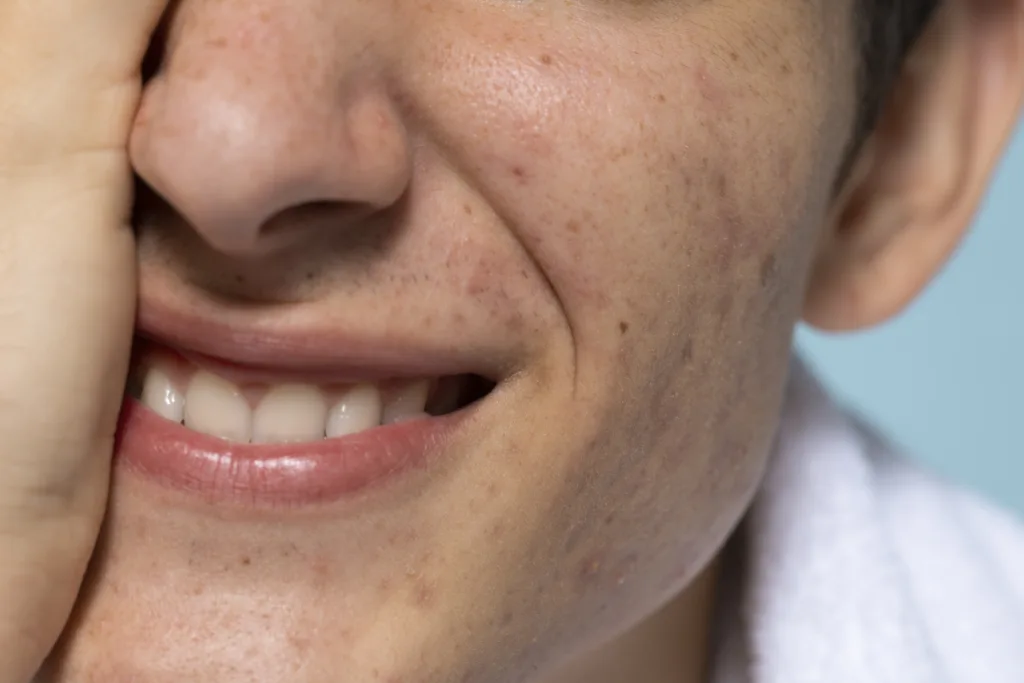Everyone wants healthy, clear skin, and the products we use play a big role in achieving that goal. Moisturizers are super important for keeping our skin hydrated and preventing it from getting dry. You might have heard about a non comedogenic moisturizer, which is popular because it claims to be less likely to cause acne. But here’s the thing – is that really true? Let’s find out! In this article, we’ll talk about what “non comedogenic” means, check out what’s inside these moisturizers, and chat about things that might make acne pop up.
Table of Contents
The Relationship Between Moisturizers and Acne

So, you’re curious about the link between moisturizers and acne, huh? Well, buckle up because we’re about to dive into the world of skincare magic. Let’s start with the main lead of our story: the non comedogenic moisturizer.
How Non comedogenic Moisturizer Contributes to Acne-Free Skin
Picture your face as the main character in a story, fighting off bad guys (acne) to become as smooth and glowy as a K-pop idol. Enter non comedogenic moisturizers the unsung heroes in your skincare routine. These aren’t your average moisturizers; they go beyond the call of duty.
Wondering how they work their magic? Non comedogenic moisturizer is crafted to hydrate your skin without clogging those precious pores. Yes, you heard it right – no pore-clogging drama here! They’re like the secret agents of skincare, keeping your skin moisturized and happy without inviting acne to the party.
So, what sets them apart from the rest? Unlike their counterparts, non comedogenic moisturizer won’t weigh your skin down with heavy oils or pore-blocking ingredients. It’s like giving your skin a breath of fresh air – light, refreshing, and oh-so-comfortable.
But hey, the best part? These moisturizers don’t just hydrate; they actively combat acne. They’re on a mission to keep your skin clear, ensuring that pesky breakouts don’t steal the spotlight.
In this section, we’re spilling the beans on how a non comedogenic moisturizer play a crucial role in your quest for radiant and acne-free skin. So, stay with us as we unravel the secrets behind the glow!
Understanding the Basics of Non comedogenic Skincare
Now that we’ve got the spotlight on non comedogenic moisturizer, let’s break down the basics. What exactly makes them stand out in the world of skincare? In this part, we’ll explore the fundamental principles that set non comedogenic skincare apart from the crowd.
The Mechanism at Play: How Non comedogenic Products Combat Acne
Ever wondered about the superhero moves of non comedogenic products in the battle against acne? Prepare to be amazed! We’re going to uncover the specific ways these skincare superheroes work their magic to keep those acne villains at bay.
Clearing the Confusion: Non comedogenic vs. Oil-Free Explained
Confused about the terms “non comedogenic” and “oil-free”? Don’t worry; you’re not alone. Let’s clear up the confusion and get to the bottom of what makes non comedogenic products different from their oil-free counterparts:
Noncomedogenic: The Pore Defender
- Focus: Primarily designed to prevent pore-clogging.
- Objective: Aims to minimize the likelihood of acne and breakouts.
- Key Feature: Formulated to be gentle on the skin, reducing the risk of blocked pores without excluding all oils.
- Ideal For: Those seeking hydration without compromising on skin health.
Oil-Free: The Oil Evictor
- Focus: Excludes oils from the formulation.
- Objective: Targets individuals who want a product devoid of any oil-based ingredients.
- Key Feature: Emphasizes the absence of oils, making it suitable for those with oily skin or a preference for a lightweight feel.
- Ideal For: Individuals looking to avoid any oil-related concerns or for those with naturally oily skin.
In essence, while both noncomedogenic and oil-free products cater to specific skincare needs, noncomedogenic formulations prioritize preventing pore blockages, whereas oil-free products emphasize the exclusion of oils altogether. Selecting the right type depends on your individual skin goals and preferences.
Navigating Ingredients Choices for Clear Skin

Alright, let’s embark on a skincare adventure – it’s ingredient exploration time! We’re delving into the fascinating world of non comedogenic moisturizers, unravelling the mysteries of what to embrace and what to avoid for that coveted clear skin.
Risky Business: Identifying Comedogenic Ingredients to Dodge
Picture this – some ingredients are like troublemakers at a skincare party. They can wreak havoc on your skin, causing unwanted breakouts. So, here’s your hit list of comedogenic ingredients to steer clear of:
- Coconut oil: It might be trendy, but for some, it’s a breakout trigger.
- Algae extract: Despite its sea-inspired allure, it can be a pore-clogging culprit.
- Wheat germ oil: Sounds healthy, but it may not play nice with acne-prone skin.
- Soybean oil: Proceed with caution, as it could be a silent troublemaker.
Pore-Perfect Choices: Embracing Non comedogenic Ingredients
Now, let’s shift gears and focus on the good stuff – ingredients that won’t sabotage your skin’s party. Here’s your lineup of non comedogenic ingredients, the heroes of clear and happy skin:
- Hyaluronic acid: A hydration wizard without the pore-clogging drama.
- Glycerin: Locks in moisture minus the acne invitation.
- Niacinamide (Vitamin B3): Fights acne and boosts skin resilience.
- Salicylic acid: A blemish-busting ingredient that won’t clog your pores.
Ingredient Intelligence: Selecting Acne-Friendly Components
It’s not just about avoiding the bad guys; it’s about recruiting the Avengers for your skincare squad. Let’s break down the Power Puff ingredients that actively contribute to your battle against acne:
- Tea tree oil: Nature’s antibacterial powerhouse.
- Alpha hydroxy acids (AHAs): Exfoliate and rejuvenate without the acne aftermath.
- Zinc: Regulates oil production and supports skin healing.
- Green tea extract: An antioxidant ally in the fight against inflammation.
There you have it – a guide to navigating the ingredient jungle. In the next part, we’ll explore how these ingredients work their magic in non comedogenic moisturizers, so you can confidently curate your skincare routine for clear and radiant skin!
Assessing the Impact on Acne

Welcome to the detective work of skincare! In this section, we’re putting on our investigative hats to explore the intricate relationship between your skincare routine, non comedogenic moisturizers, and those pesky breakouts.
Breakout Watch: the Link Between Non comedogenic Products and Acne
Alright, let’s talk about the elephant in the room – can non comedogenic products, especially moisturizers, still be culprits in the grand breakout scheme? The truth is, while non comedogenic moisturizers are designed to be gentle on your skin, factors like individual sensitivities and improper usage can sometimes throw a curveball.
Possible culprits to watch out for:
- Overapplication: Too much of a good thing can be, well, too much. Over-moisturizing might tip the balance and lead to breakouts.
- Incompatible Products: Mixing non comedogenic products with incompatible ones could stir up trouble. Check the compatibility of your skincare squad.
Moisture Moderation: Signs Your Skincare Routine Maybe Too Much
Ever felt like your skin is throwing a tantrum? It might be trying to tell you something. Here are signs that your skincare routine, even with non comedogenic moisturizers, might be a tad excessive:
- Your Skin is Super Dry: Ironically, over-moisturizing can leave your skin feeling parched.
- Pore Congestion Alert: If those pores start feeling like they’re playing host to a block party, it might be a sign to ease up.
- Frequent breakout appearances: The irony is real. Too much moisture might be leading to unwanted breakouts.
- Sebum Surge: Your skin rebels by producing excess oil in response to too much moisture.
- Skin’s feeling the squeeze: Healthy skin shouldn’t feel like it’s about to burst out of its seams. Tightness might indicate over-moisturizing.
Building Your Non Comedogenic Skincare Routine

Ready to level up your skincare routine? This section is all about crafting a lineup that’s as unique as you are, featuring the superstar ingredient: the non comedogenic moisturizer. Let’s dive in!
Selecting Wisely: Tips for Building Your Non Comedogenic Skincare Regimen
Building a skincare routine is like curating your own beauty symphony. Here are some practical tips to ensure your skincare routine is the orchestra your skin deserves:
- Patch Testing: Before committing to a new non comedogenic moisturizer, give it a test run on a small area. Your skin deserves a proper introduction.
- Consistency is Key: Your skin loves routine. Stick to a consistent skincare routine rather than bombarding it with an ever-changing lineup.
- Tailor to Your Skin Type: Not all heroes wear capes, and not all non comedogenic moisturizers suit every skin type. Identify your skin type and choose products that cater to its unique needs.
- Consult a Skincare Professional: When in doubt, seek wisdom from the skincare gurus. A skincare professional can guide you on the path to radiant skin, ensuring that your routine is both no-sweat and effective.
Formula for Success: Key Ingredients to Seek in Non Comedogenic Moisturizers
Let’s talk ingredients – the building blocks of your skincare masterpiece. When on the lookout for non comedogenic moisturizers, keep an eye out for these hero ingredients:
- Hyaluronic Acid: A hydration powerhouse that won’t weigh your skin down.
- Glycerin: Locks in moisture without clogging those precious pores.
- Niacinamide (Vitamin B3): A multitasker that battles acne and boosts your skin’s resilience.
- Salicylic Acid: The blemish-busting ingredient that keeps pores in check.
Now that you’ve got the key ingredients in your arsenal, let’s explore how to incorporate them into your routine seamlessly.
Sunscreen Shield: Non Comedogenic Sunscreen for Acne-Prone Skin
Now, let’s shed some light on the unsung hero of skincare – sunscreen! When it comes to acne-prone skin, choosing the right sunscreen is crucial. Let’s break down the key ingredients that make a non comedogenic sunscreen your skin’s best friend.
Essential Ingredients for a Non Comedogenic Sunscreen:
- Titanium Dioxide and Zinc Oxide: These mineral ingredients provide broad-spectrum protection without causing breakouts. They sit on the skin’s surface, creating a barrier against harmful UV rays.
- Oil-Free Formulas: Opt for sunscreens labelled as “oil-free” to prevent pore congestion and excess shine.
- Non-Greasy Texture: Lightweight and non-greasy formulations are ideal for acne-prone skin, ensuring your skin stays protected without feeling heavy.
Non-Comedogenic Sunscreen Recommendations:
La Roche-Posay Anthelios Melt-in Milk Sunscreen:
- Lightweight and non-greasy.
- Contains antioxidants for added skin benefits.
- Suitable for daily use, even under makeup.
Neutrogena Hydro Boost Water Gel Lotion SPF 30:
- Hydrating formula that won’t clog pores.
- Water-gel texture for a refreshing feel.
- Provides broad-spectrum UVA/UVB protection.
EltaMD UV Clear Broad-Spectrum SPF 46:
- Formulated with niacinamide to soothe and calm the skin.
- Suitable for sensitive and acne-prone skin.
- Transparent zinc oxide for effective sun protection.
Choosing the right sunscreen can make a world of difference for your acne-prone skin. Now, let’s explore the importance of opting for fragrance-free products in your skincare routine – a wise move for skin that’s prone to breakouts and sensitivities.
Tailoring Non Comedogenic Solutions to Your Skin Type

Ready for a skincare journey customized just for you? In this section, we’ll match your unique skin type with non comedogenic moisturizers that meet your specific needs. Let’s find your perfect skincare companion!
Non Comedogenic Moisturizers for Oily Skin
Oily skin warriors, meet your match:
- Cetaphil PRO Oil Absorbing Moisturizer:
- Controls oil without clogging pores.
- Provides lightweight hydration.
- Neutrogena Hydro Boost Water Gel:
- Hydrates without adding excess oil.
- Water-gel formula for a refreshing feel.
- Paula’s Choice RESIST Youth-Extending Daily Hydrating Fluid SPF 50:
- Matte finish for a shine-free look.
- Sunscreen protection without pore congestion.
Ingredients to Embrace:
- Hyaluronic Acid: Provides lightweight hydration.
- Glycerin: Locks in moisture without adding oil.
- Salicylic Acid: Exfoliates and unclogs pores.
Ingredients to Avoid:
- Heavy Oils: Opt for oil-free formulations to prevent excess oiliness.
- Alcohol: High alcohol content can strip the skin and stimulate more oil production.
Non Comedogenic Moisturizers for Dry Skin
Dry skin deserves a moisture boost without the clog:
- CeraVe Moisturizing Cream:
- Rich in ceramides for intense hydration.
- Nourishing without causing congestion.
- Aveeno Positively Radiant Daily Moisturizer:
- Infused with soy complex for deep nourishment.
- Restores and maintains skin’s moisture balance.
- Vanicream Moisturizing Cream:
- Free of common irritants.
- Ideal for dry and sensitive skin.
Ingredients to Embrace:
- Ceramides: Reinforce the skin barrier for lasting hydration.
- Hyaluronic Acid: Attracts and retains moisture.
- Glycerin: Provides a surge of hydration.
Ingredients to Avoid:
- Fragrances: Fragranced products can be irritating for dry and sensitive skin.
- Harsh Chemicals: Opt for gentle formulations to avoid further dryness.
- Alcohol: Some alcohols can be drying; opt for fatty alcohols like cetyl and stearyl alcohol.
Non Comedogenic Moisturizers for Combination Skin
Balancing act for combination skin? These moisturizers have got you covered:
- Clinique Dramatically Different Moisturizing Gel:
- Lightweight hydration for oily zones.
- Balances combination skin.
- First Aid Beauty Ultra Repair Face Moisturizer:
- Strikes the right moisture balance.
- Nourishes without causing breakouts.
- La Roche-Posay Toleriane Double Repair Face Moisturizer:
- Provides dual-action moisture for combination skin.
Ingredients to Embrace:
- Niacinamide: Balances oil production.
- Hyaluronic Acid: Maintains hydration in dry areas.
- Lightweight Emollients: Ensure moisture without heaviness.
Ingredients to Avoid:
- Artificial Fragrances: Potential irritants for sensitive areas.
- Mineral Oil: Heavy oils can exacerbate oiliness in the T-zone.
- Harsh Acids: While some acids are beneficial, strong ones may disrupt the balance of combination skin.
- Overly Rich Formulas: Heavy creams may be too much for oily areas.
Non Comedogenic Moisturizer for Sensitive Skin
Sensitive skin needs extra care – here are your go-to moisturizers:
- Avene Tolerance Extreme Emulsion:
- Minimalist formula for ultra-sensitive skin.
- Soothes without irritating.
- Eucerin Advanced Repair Cream:
- Fragrance-free and suitable for sensitive skin.
- Strengthens the skin’s protective barrier.
- Cetaphil Redness Relieving Night Moisturizer:
- Calming relief for sensitive, red-prone skin.
- Non comedogenic formula for gentle care.
Ingredients to Embrace:
- Aloe Vera: Soothes and calms sensitive skin.
- Chamomile Extract: Anti-inflammatory properties for gentle care.
- Ceramides: Strengthens the skin barrier.
Ingredients to Avoid:
- Synthetic Fragrances: Potential irritants for sensitive skin.
- Alcohol: Can be drying and irritating for sensitive skin.
- Essential Oils: While natural, they can trigger reactions in sensitive skin.
Next, let’s dive into the nitty-gritty of non comedogenic ingredients and how they contribute to your quest for clear and healthy skin. Stay tuned for more skincare wisdom!
Addressing Specific Skin Concerns

Welcome to the troubleshooters’ corner of your skincare journey! In this section, we’re diving deep into specific skin concerns, armed with practical tips and the magic touch of non comedogenic moisturizers.
Taming the Shine: Tips for Oily Skin
Hey, oily skin pals – let’s keep that shine in check with these non comedogenic tips:
- Balanced Hydration: Opt for water-based non comedogenic moisturizers. Try the Neutrogena Hydro Boost Water Gel for lightweight hydration.
- Blotting Papers: Keep blotting papers like Clean & Clear Oil Absorbing Sheets handy. A quick blot helps control excess oil without disrupting your makeup.
Quenching the Thirst: Tips for Dry Skin
Calling all dry skin enthusiasts! Here’s how to quench your skin’s thirst for hydration:
- Layering Techniques: Consider layering lighter and heavier non comedogenic moisturizers. Start with a hydrating serum like The Ordinary Hyaluronic Acid 2% + B5 and follow up with a rich moisturizer like CeraVe Moisturizing Cream for extra hydration.
- Humidifier Use: Introduce a humidifier to your environment. It adds moisture to the air, benefiting your skin. The Levoit Humidifier is a reliable choice.
Striking the Balance: Tips for Combination Skin
For those navigating the balance beam of combination skin, here are practical tips:
- Zone-Specific Application: Apply lighter non comedogenic moisturizers to oily zones and richer ones to drier areas. The Clinique Dramatically Different Moisturizing Gel works well for oily areas, while the CeraVe Moisturizing Cream provides nourishment for drier regions.
- Consistent Moisture: Maintain a consistent routine with products like the La Roche-Posay Toleriane Double Repair Face Moisturizer. Regular, gentle care helps keep your skin’s balance intact.
Delicate Defense: Tips for Sensitive Skin
Sensitive skin requires an extra layer of care. Here are tips for nurturing sensitive skin:
- Patch Testing: Always patch-test new products, even non comedogenic ones. Consider the Avene Tolerance Extreme Emulsion, a minimalist formula for ultra-sensitive skin.
- Gentle Application: Apply non comedogenic moisturizers with a light touch. The Eucerin Advanced Repair Cream is fragrance-free and suitable for sensitive skin.
There you have it – in-depth tips for addressing specific skin concerns with the help of carefully chosen non comedogenic practices and products.
Conclusion
So, to wrap it up – non-comedogenic moisturizers are generally made to be nice to your skin and not cause acne. But everyone’s skin is different, so pay attention to what works for you. Check out the ingredients, do a little test, and take good care of your skin. Instead of assuming that all non-comedogenic moisturizers are the same, treat your skin like the unique superstar it is!
FAQs
Q1: What does “noncomedogenic” mean in skincare?
A: Noncomedogenic refers to products, like moisturizers, formulated to not clog pores. They are designed to hydrate the skin without causing acne or breakouts.
Q2: How do I know if a product is noncomedogenic?
A: Look for labels explicitly stating “noncomedogenic.” Additionally, check for key ingredients like hyaluronic acid and avoid known comedogenic ingredients.
Q3: Can noncomedogenic moisturizers be used for all skin types?
A: Yes, noncomedogenic moisturizers are suitable for various skin types. Tailor your choice based on your skin’s specific needs – whether it’s oily, dry, combination, or sensitive.
Q4: Are noncomedogenic and oil-free products the same?
A: Not necessarily. While noncomedogenic products avoid pore-clogging, oil-free products may still contain comedogenic ingredients. Always check labels for a comprehensive understanding.
Q5: Can noncomedogenic products still cause breakouts?
A: While noncomedogenic products are less likely to cause breakouts, individual skin sensitivity and overuse can still lead to issues. Ensure proper application and monitor your skin’s response.
Q6: What are some signs of over-moisturizing with noncomedogenic products?
A: Signs include excessively dry skin, clogged pores, increased breakouts, heightened sebum production, and a tight feeling on the skin.
Q7: Can I use noncomedogenic moisturizers with other skincare products?
A: Yes, you can. Ensure compatibility by patch-testing new products and maintaining a consistent routine. Consult a skincare professional for personalized advice.
Q8: How important is sunscreen in a noncomedogenic skincare routine?
A: Sunscreen is crucial. Opt for non-comedogenic options with mineral ingredients like titanium dioxide and zinc oxide to protect your skin without causing breakouts.
Q9: What’s the significance of fragrance-free products for acne-prone skin?
A: Fragrances can be irritating to sensitive skin. Choosing fragrance-free options reduces the risk of skin reactions, especially for those prone to acne.
Q10: How often should I update my noncomedogenic skincare routine?
A: Stick to a consistent routine. Update if you notice changes in your skin’s needs or if new products align better with your goals. Always patch-test new additions.



Leave a Reply